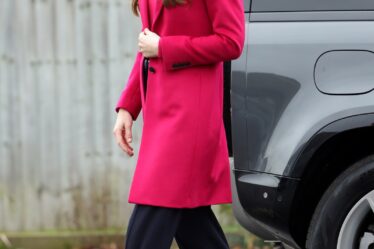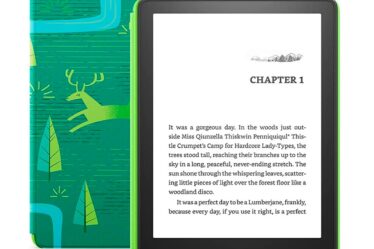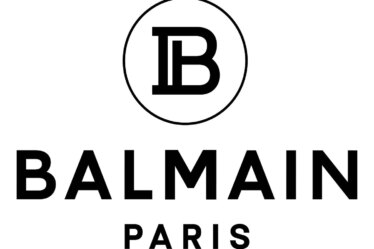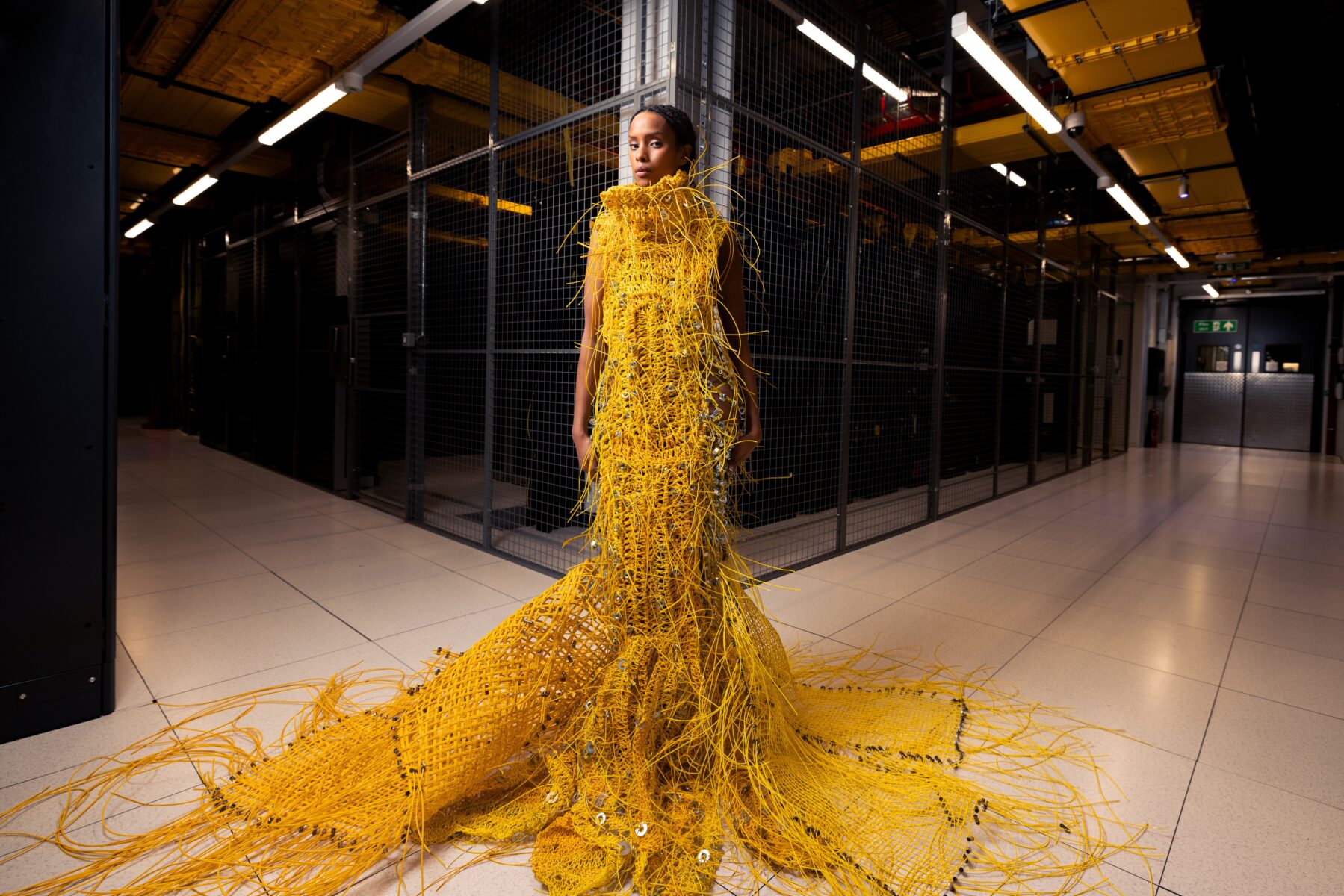
Inviting us into his wonderfully woven dystopia, Derbyshire-born Maximilian Raynor transported audiences to the year 3025 for his solo debut show since graduating from Central Saint Martins’ MA course last year (don’t worry, the trip was worth it).
In a world marked by the shadow of financial gain and technological improvements – where wood is as sought after as gold, the brunt of climate change is seen and felt, and the natural world a mere memory that whispers itself through storms and barren landscapes – Welcome to the Un-United Kingdom, takes form as Maximilian Raynor’s peek into a whimsically dystopian future.
With his usual flair for the dramatic, Raynor’s off-schedule show for London Fashion Week took place on Thursday – his first show in almost a year since presenting his Central Saint Martin’s MA collection. Framed within the walls of an East London venue: smoke and car wreckage smothered the warehouse, hay bales operated as makeshift seats for the fash pack, as two men wearing next to nothing performed an interlocked dance duet together, setting the tone for Raynor’s immersive experience. It started with the musical rumble of a circus motif serenading the space, as a single model clutches onto a cluster of black balloons and glides down the runway. Her patchwork plaid suit washed in burnt oranges and turquoises, sitting amidst elongated lapels glazed in a black PVC leather – a Maximilian staple.
It’s not often that a garment can be so easily connoted to a designer after presenting only two collections in their career (one of which shown pre-graduating), but the Maximilian Raynor uniform was palpable from start to finish. This perhaps exemplifies his rapid ascent into the fashion world, having gained traction from a roster of celebrities including Chappell Roan, Lady Gaga, Rita Ora and Amelia Dimoldenberg. The hype is real when it comes to Maximilian Raynor.
In sponsorship with the non-profit organisation Hi-Fi (Hidden Fashion Initiative) – the programme allowing young designers to execute their creative visions to the fullest potential with the help of Hi-Fi’s time, resources and experience – Raynor’s ambitious vision for AW25 was able to flourish. Guests were greeted into the Shoreditch venue with The Personification of Internet Herself: a model was seen laying motionless, boasting a bright yellow sporadically wire-woven gown, fashioned entirely from cabling materials donated by Equinix – a digital data infrastructure company. The garment, which took 640 hours to create (about six months of work), uses fibre optic cables, nuts and bolts recovered from Equinix’s data centres: not only celebrating Raynor’s technical capabilities, but it also highlights the material quality of something as intangible as the digital world.
Chock-full of shredded fabrics, 1970s silhouettes, hodge podge tartan prints and theatrical interludes, Raynor’s immersive world was cemented by his undeniably untameable energy as a young designer to watch. Lucky for you, we’re in-the-know, and you can be too, as we caught up with Raynor to debrief on his AW25 collection, his dream muses, and all-time inspirations…
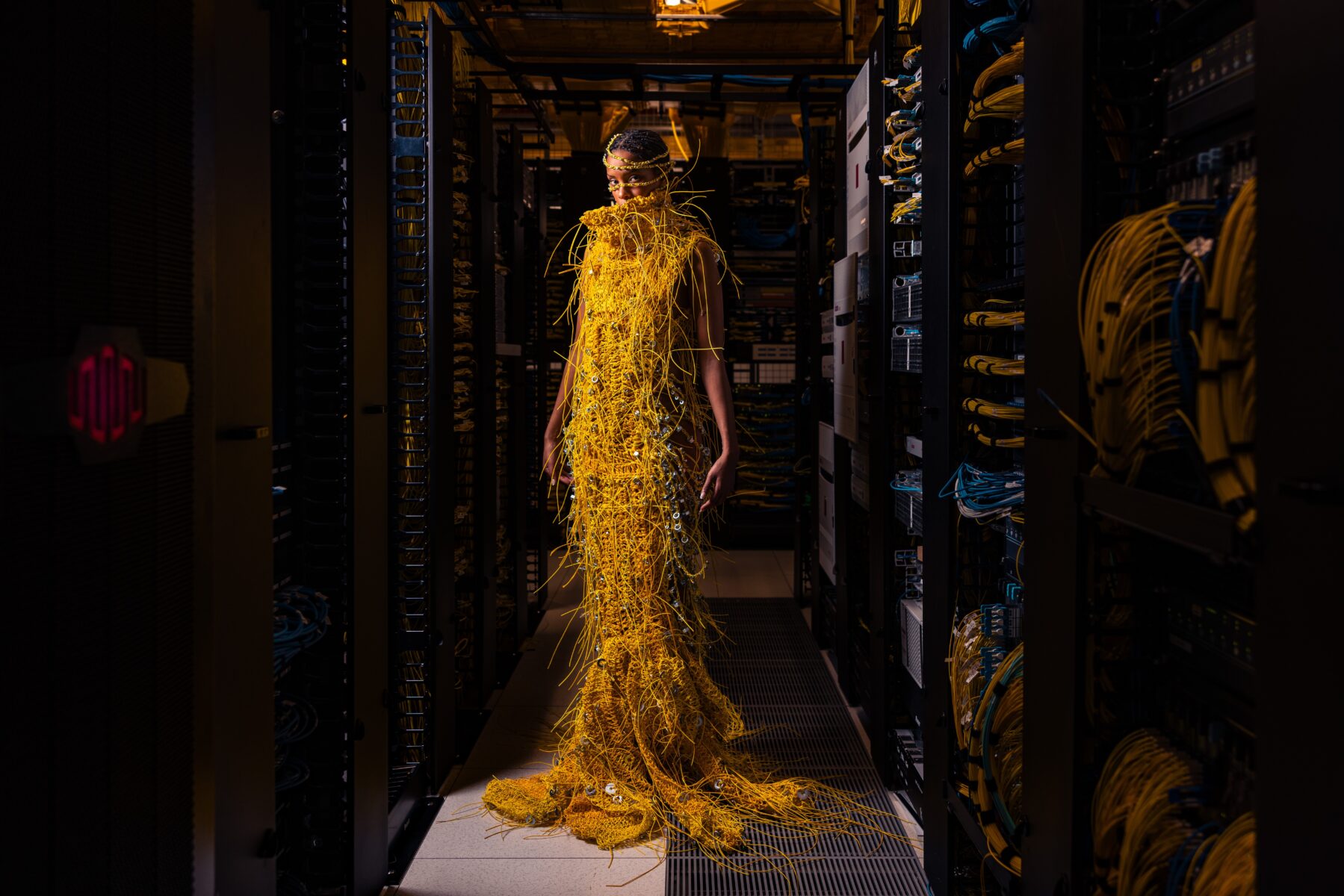
Hi Max, thanks so much for chatting with us. How are you today? What does a day in your life look like in the final stretch before LFW?
A day in my life is wildly hectic and at times can be borderline unmanageable, but we are so excited. I’m feeling a lot of gratitude at the moment for all the people and creatives who’ve come on board to support the vision for my London Fashion Week project – most notably Hi Fi, the non-profit initiative that supports emerging designers and artists. Without whom, I wouldn’t have the backing for this show. HiFi is such a rare initiative, and I think there should be more support networks out there like it. Networks that catch talent that perhaps otherwise would have fallen under the radar without financial backing.
Before we dive into your latest project, take us back to the beginning. How did your journey into fashion start, and when did you first realise it was your calling?
As a child, I was always obsessed with sketching and drawing and would often design whole collections in one night. To pick out the colours for my designs, I’d cover my eyes and whichever colour pens I blind-selected, I’d build a collection with that palette. This passion extended into the desire to make real clothes when I was around the age of seven. Growing up in the countryside, I would use whatever material I could get my hands on – old dog blankets or old curtains, you name it. My two neighbours were young girls and we would do fashion shoots for what we used to call Maximilian Magazine. We’d imagine we were doing some huge Tim Walker shoot when in reality it was a tartan dog blanket covered with hair!
The dream was always there and that passion continued to grow as I started writing to my idols. I’ve spoken about it a lot, but when I was 10 years old, Vivienne Westwood replied to one of my letters, inviting me to her London studio to shadow her work for a week. At that age, the experience was eye-opening and fueled my desire to pursue fashion, having had that validation from such an idol. At school, my wonderful textiles teacher, Sidony Swan, would encourage me to be involved in the A Level and GCSE fashion show – despite only being in Year 7! Each year the number of looks grew and a particular favourite was my collection in Year 10, which was inspired by the Grenadier Guards – the Queen’s Guards. It was always such a special experience and I was very grateful to be included so young. By A Level I was creating these massive collections, some of which were quite prom dressy – but I’ve developed a lot since then. All this development in my early days as a designer was what led me to apply to Central Saint Martin’s.
Who were some of your biggest inspirations early on? Do they still shape the way you approach your work today?
My earliest inspirations were definitely Vivienne Westwood, Alexander McQueen, and John Galliano. I will always cite those three as my absolute north stars when it comes to design inspiration, but beyond that it was the literature and the books that I was reading – lots of tales of tragedy. I was obsessed with Shakespeare – Romeo and Juliet and Macbeth – as well as films like Atonement. Think Keira Knightley, you know, heroines on rocks in the middle of the Derbyshire moors! I loved Jane Eyre and the Bronte Sisters. Choreographer, Matthew Bourne, was also a huge influence to me. His productions of The Nutcracker and Swan Lake were both deep inspirations. Baz Luhrmann too – I couldn’t not mention him! The way he curates films and tells stories – mixing together a kind of full-blown drama, glamour and camp in a way that pushes boundaries but remains tasteful.

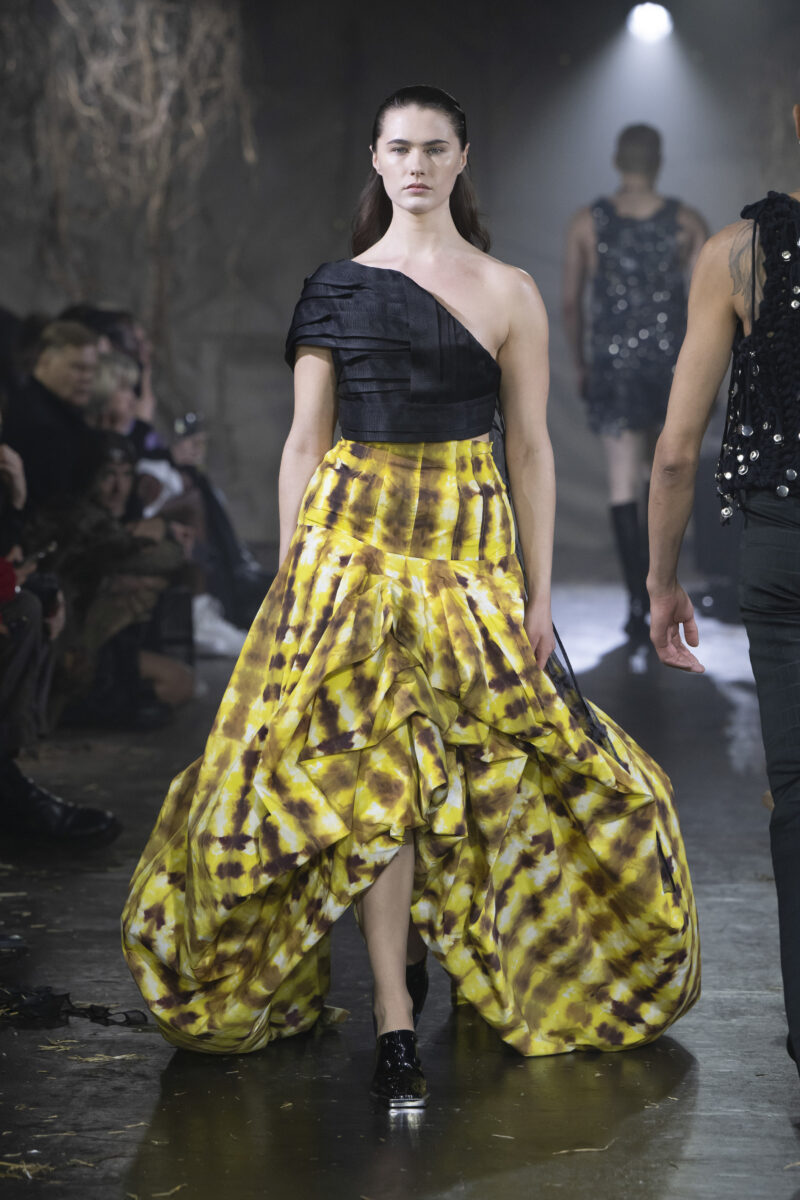
Courtesy of Maximilian Raynor
How did this collaboration with Equinix come to life?
Equinix approached me directly, looking for an emerging designer or artist to conceptualise an essential truth: that the internet doesn’t reside in an invisible “cloud” but relies on physical networks that allow us to connect to one another every day, instantaneously.
It was a very exciting prospect and I was immediately inspired by the idea of the wire cabling and material used at Equinix data centres that forge the physical connections, to enable our digital lives. I was inspired to build a character around the Equinix material – as I always do with a project. The process was organic and quite immediate – the idea came to me pretty quickly and then it was just about figuring out the team that was required to put such an ambitious look together.
Fashion and data aren’t two worlds people often connect—how do you see them intersecting, and how do you navigate this space?
I think it’s interesting how oppositional we often place science and humanities or fashion and tech. That’s what has been so refreshing and exciting about this project with Equinix: the fusion of the two worlds and realising that there are far more similarities and connections between the two than we’d originally thought. Creative thinking, accuracy and technology is needed in both fields and this project is really a visual symboliser of how industries working together, or finding inspiration in the unconventional, can result in inspiring and thought-provoking outcomes.
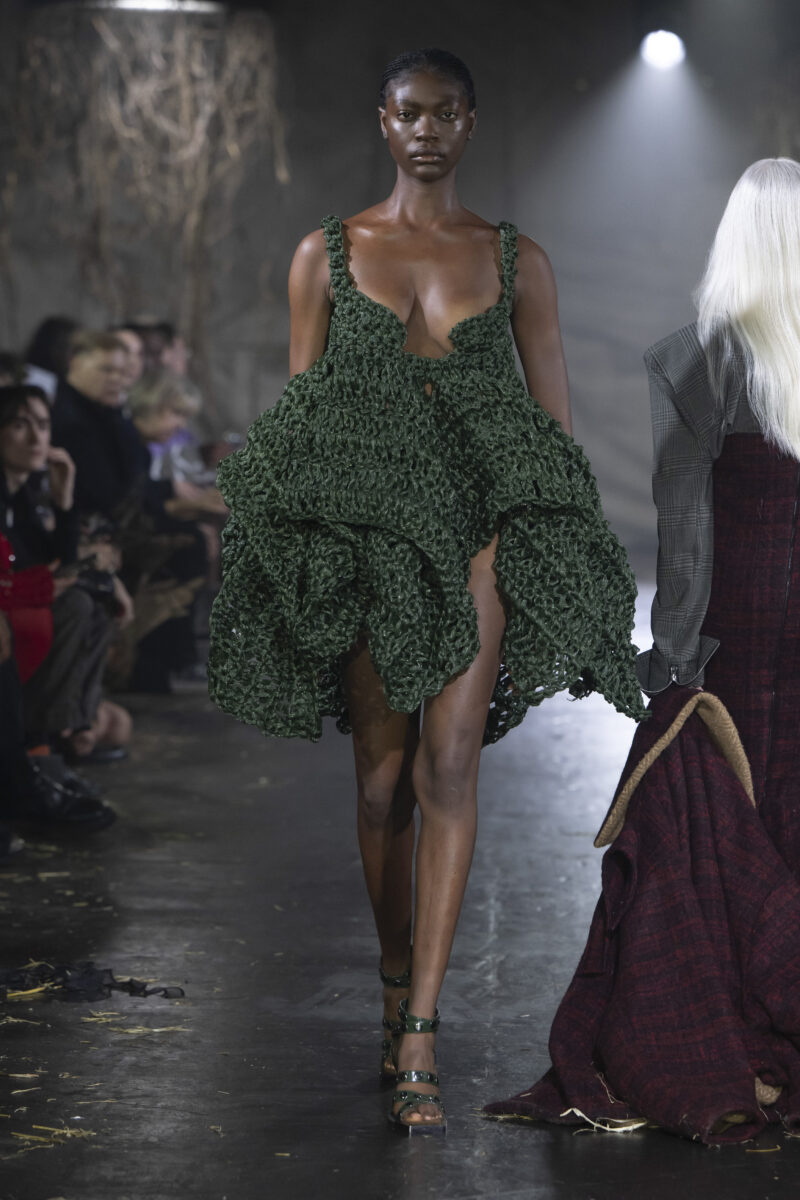
Courtesy of Maximilian Raynor
What was your creative process in bringing this piece to life? Where did you start, and what guided your decisions along the way?
The project with Equinix began with the idea of the personification of the internet or the personification of data. It developed into an ambition to create a female muse – this powerful woman emerged from the wires. I wanted it to feel sort of sinister, but enticing at the same time. The yellow wires that Equinix uses in its data centres were obviously a leading force of the design – creating a bold block-coloured look and then using metal bolts and washers to accent and bring light and life to the look.
I worked very closely with Isabella Egan, who is my sort of informal Head of Knitwear at my small emerging design studio. She was the mastermind behind how to realise my design with crochet. We then brought in a team of crochet interns and students (Aidan Thompson, Natasza Szczepanski, Max Lewisohn, Grace Mulley, Di Wen Su, Yasmin Kenny, Ellie Joseph and Safiya Curtis) who were inspired by my work and wanted to volunteer on the project. This led to hours of crochet work – 640 to be exact – as well as some weaving with my core design studio team.
Your designs are known for their innovation. How does repurposing materials fit into that ethos, and why is sustainability such a key part of your work?
My brand is by no means entirely sustainable. I think putting product out into the world is kind of oppositional to the idea, but that doesn’t negate the fact that there’s an appetite for art in the world and there’s an appetite for the new. So, when creating, it’s important to ask ourselves how we can make choices that have less of an impact and could incite change? My ethos behind all my projects is about how we can repurpose a material that may otherwise have been used in a different way, as well as rethinking how and where we source it from in order to tell a story and allow people think differently.
If you could choose anyone to wear this dress, who would be your dream muse?
I’d love to see this look on a major movie star. I could really imagine Lupita Nyong’o wearing this or perhaps Zendaya to a Dune premiere. Who knows, but you’ve got to aim high!
Looking ahead, what excites you most about the future?
I’m really excited to see the response to the show at London Fashion Week. We’ve poured absolutely everything possible into it, and if it goes the way we intend, it should be something really special and memorable that bridges the gap between all the art forms of music, dance, fashion, scent, environment, and so on. I hope people love it as much as I do.
More broadly, I’m excited to continue working with my idols and collaborating with the photographers, models, icons and muses that I’ve always dreamt of working with. Sustaining an emerging brand is a difficult thing to do – but with the support of HiFi I’ve been able to make that step into the next stage of my design journey which is showing solo and showing independently. I want to continue putting work out into the world and see what comes back to me. That’s what I’ve always done and it seems to be working.
Words — Freya Goodchild-Bridge
Content shared from www.wonderlandmagazine.com.

